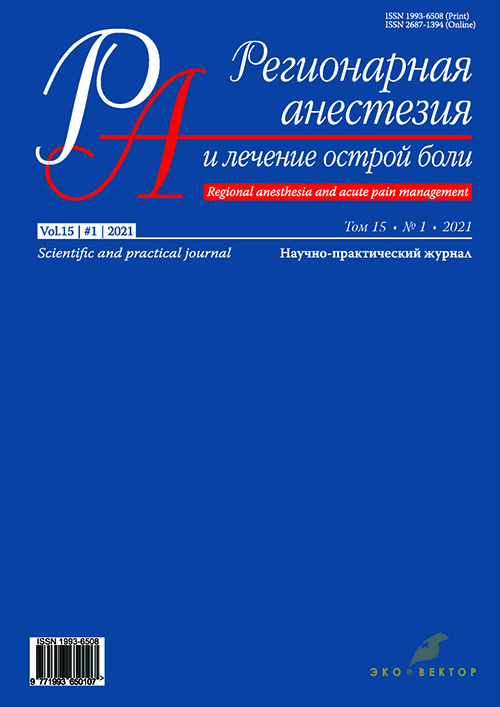Блокада крылонёбной ямки и дексмедетомидин как компоненты стресс-лимитирующей анестезии в офтальмохирургии
- Авторы: Мынка Н.В.1,2, Кобеляцкий Ю.Ю.1
-
Учреждения:
- Днепропетровская медицинская академия
- Днепропетровская областная клиническая офтальмологическая больница
- Выпуск: Том 15, № 1 (2021)
- Страницы: 33-40
- Раздел: Оригинальные исследования
- Статья получена: 09.07.2021
- Статья одобрена: 09.07.2021
- Статья опубликована: 15.01.2021
- URL: https://rjraap.com/1993-6508/article/view/75936
- DOI: https://doi.org/10.17816/RA75936
- ID: 75936
Цитировать
Полный текст
Аннотация
На сегодняшний день оперативные вмешательства продолжают сопровождаться высокой долей развития осложнений и даже смертью. При этом подсчитано, что в половине случаев летальность и серьёзные послеоперационные осложнения можно было предупредить. После всестороннего изучения факторов, влияющих на продление сроков госпитализации и реабилитации (Kehlet H., 1997; Kehlet H., Wilmore D., 2002), было определено, что именно хирургический стресс-ответ представляет собой наиболее значимый индуктор нарушения функционирования различных органов и систем. Общая анестезия в классическом её понимании не в состоянии предоставить пациенту полную защиту от операционной травмы. Более полноценную защиту можно получить сочетанием общей, местной анестезии с применением стресс-протекторных препаратов.
Целью данного исследования было оценить эффективность и безопасность предложенной схемы стресс-лимитирующей анестезии у офтальмохирургических пациентов при трансплантации роговицы.
Материалы и методы. В приведённом исследовании проводится сравнительная характеристика выраженности стресс-ответа и болевого синдрома у пациентов, оперированных в условиях «классической» общей анестезии (группа К) с пациентами, которым применялась схема стресс-лимитирующей анестезии (группа ДБ). В обеих группах была выполнена многокомпонентная анестезия, в группе К для седации использовали сибазон, в группе ДБ − дексмедетомидин. Также пациентам группы ДБ перед оперативным вмешательством была выполнена местная анестезия. Основными критериями оценки результатов были приняты: гемодинамическая стабильность, глюкоза крови, уровень лейкоцитов венозной крови и выраженность боли по ВАШ в послеоперационном периоде.
Результаты. Обе схемы позволяли избежать выраженных колебаний показателей гемодинамики и газообмена на всех этапах исследования. При анализе показателей глюкозы крови и лейкоцитов было установлено, что у пациентов контрольной группы наблюдалось более значительное отклонение обоих показателей от дооперационного уровня, чем в группе стресс-лимитирующей анестезии. При исследовании болевого синдрома было определено, что в группе контроля уровень боли по ВАШ был выше на всех этапах исследования по сравнению с пациентами группы стресс-лимитирующей анестезии.
Выводы. Схема стресс-лимитирующей анестезии позволяет контролировать послеоперационную боль без дополнительного использования наркотических анальгетиков и блокад в послеоперационном периоде.
Ключевые слова
Полный текст
Об авторах
Надежда Вячеславовна Мынка
Днепропетровская медицинская академия; Днепропетровская областная клиническая офтальмологическая больница
Автор, ответственный за переписку.
Email: nice.barannik@ukr.net
ORCID iD: 0000-0001-5024-911X
аспирант кафедры
Украина, 49044, Днепр, ул. В. Вернадского, 9; ДнепрЮрий Юрьевич Кобеляцкий
Днепропетровская медицинская академия
Email: kobeliatsky@ukr.net
ORCID iD: 0000-0002-8504-6125
д.м.н., профессор
Украина, 49044, Днепр, ул. В. Вернадского, 9Список литературы
- Кобеляцкий Ю.Ю. Новые подходы к регуляции операционного стресс-ответа // Здоровье Украины. 2017. № 2. С. 2–6.
- Овечкин А.М. Хирургический стресс-ответ, его патофизиологическая значимость и способы модуляции // Регионарная анестезия и лечение боли. 2008. Т. 2, № 2. С. 49–62.
- Kehlet H. Postoperative pain relief--what is the issue? // Br J Anaesth. 1994. Vol. 72, N 4. P. 375–378. doi: 10.1093/bja/72.4.375
- Desborough J.P. The stress response to trauma and surgery // Br J Anaesth. 2000. Vol. 85, N 1. P. 109–117. doi: 10.1093/bja/85.1.109
- Kehlet H. The modifying effect of anesthetic technique on the metabolic and endocrine responses to anesthesia and surgery // Acta Anaesthesiol Belg. 1988. Vol. 39, N 3. P. 143–146.
- Meiler S.E. Long-term outcome after anesthesia and surgery: remarks on the biology of a newly emerging principle in perioperative care // Anesthesiol Clin. 2006. Vol. 24, N 2. P. 255–278. doi: 10.1016/j.atc.2006.03.002
- Kehlet H., Holte K. Effect of postoperative analgesia on surgical outcome // Br J Anaesth. 2001. Vol. 87, N 1. P. 62–72. doi: 10.1093/bja/87.1.62
- Besedovsky H.O., del Rey A. Immune-neuro-endocrine interactions: facts and hypotheses // Endocr Rev. 1996. Vol. 17, N 1. P. 64–102. doi: 10.1210/edrv-17-1-64
- Beilin B., Shavit Y., Trabekin E., et al. The effects of postoperative pain management on immune response to surgery // Anesth Analg. 2003. Vol. 97, N 3. P. 822–827. doi: 10.1213/01.ane.0000078586.82810.3b
- Kasachenko V.M., Briskin B.S., Evstifeeva O.V., Savchenko Z.I. The impact of the type of anesthesia on stress-realizing and stress-limiting mechanisms of the immune system in gerontological patients at abdominal surgeries // Eksp Klin Gastroenterol. 2004. Vol., N 3. P. 58–61.
- Adams H.A., Hempelmann G. [The endocrine stress reaction in anesthesia and surgery--origin and significance] // Anasthesiol Intensivmed Notfallmed Schmerzther. 1991. Vol. 26, N 6. P. 294–305. doi: 10.1055/s-2007-1000588 (In German)
- Антомонов М.Ю. Математическая обработка и анализ медико-биологических данных. Киев: Мединформ, 2018.
Дополнительные файлы











